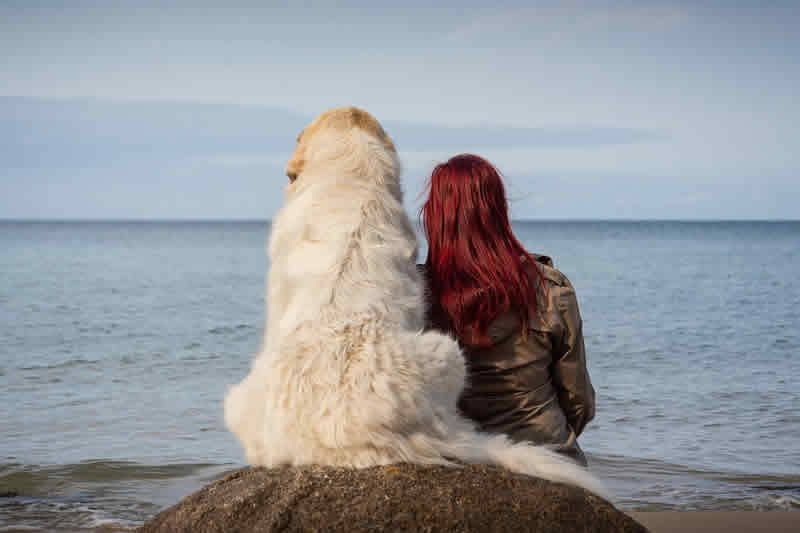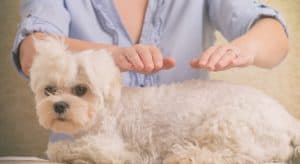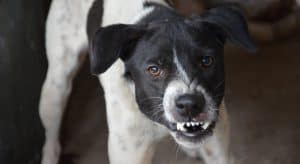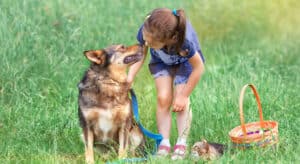We all make mistakes in life and unfortunately, we have to deal with the consequences but hopefully, we learn from them. In this article, our aim is to highlight some common mistakes new first-time dog owners make. We want to make sure you don’t fall victim to these mistakes as it will make life easier for you and your new best four-legged friend.
- Choosing The Wrong Dog Breed
- Giving Human Food To Dogs
- Hitting or Scolding A Dog
- No Socialization For Puppy
- No Boundaries or House Rules Set
- No Dog Training
- Too Much Time Alone
- Left Alone In Car/SUV/Truck
- No Teeth Brushing
- Not Enough Exercise
1. Choosing the Wrong Dog Breed
Often new dog owners do not do their homework on dog breeds and they end up choosing a dog that does not suit their home or lifestyle. We have to admit that all puppies are adorable and very cute and this cuteness can sometimes “blind” people into thinking that things will work out no matter what. While it’s always good to be optimistic, unfortunately in many cases, this does not happen. We have outlined below some of the major things to consider when choosing a dog breed:
Size
How big will my new puppy grow? You should check out the various breed characteristics and physical traits. If you can look at the pup’s parents that would give you a good indication. If that’s not possible then ask the dog breeder themselves.
You should choose a dog breed that you know will fit into your home and also a dog you can afford to look after. Some large breed dogs require a lot of food so be prepared for that additional expense too. Also if you live in an apartment or small house with no yard or space for exercise then perhaps a large breed dog would not be the most suitable choice of dog.
Dog Hair Shedding
Often many dog owners do not give enough thought to the issue of dog hair shedding and fail to do their research for a specific breed and how much hair is shed. However, for others, dog hair shedding can be a deal-breaker from the start.
You will need to ask questions. Find out does your potential new dog shed a lot of hair. If dog hair is not for you well at least you know before adopting your dog. You may decide that a non-hair shedding dog is the best option. In recent times there has been a big increase in the number of dogs available that do not shed and they are often commonly referred to as hypoallergenic dogs. If you have a household member who is allergic to dog hair then perhaps this could type of dog would be more suitable for you and your family.
Dog hair does get everywhere and if you choose a breed that sheds you need to be prepared for that. Some dogs shed more than others so it’s important to do your research on a particular breed type. Now there are ways of reducing the amount of dog hair that is shed. A regular brushing and grooming routine should be established. This will ensure your dog’s coat stays in good condition and it will also reduce the volume of dog shedding.
Although hypoallergenic dogs do not shed hair in the traditional sense they still need to be groomed and trimmed as otherwise their coat will mat, tangle, and cause all types of issues. A regular trip to the groomers will be required for hypoallergenic dogs. This will cost money so again this should be a consideration when choosing a hypoallergenic dog. Of course, you can always learn how to trim and groom yourself and it will save you a lot of money in the long term. We covered an article on the best dog clippers where you can also find some useful tips and hints.
Breed Temperament
There are over 195 dog breeds according to the American Kennel Club (AKC). Many of the dog breeds were originally bred for a particular reason. For example one of the most popular dogs in the USA is the Labrador Retriever. This breed was initially bred and used by fishermen in Newfoundland, Canada, to help them retrieve fishing nets, fetch rope and of course, be a trusted and loyal companion. Labradors are active dogs and will need plenty of exercise and attention so if this does not fit your lifestyle then perhaps another breed would be more suitable for you. Labradors are the most popular dog in the USA but sadly they are also one of the most common dogs in animal shelters. Another very popular dog in the USA are French Bulldogs. This could be a better option if you don’t have a lot of space. The French Bulldog has a reputation for not barking a whole lot, they shed very little and would be happy living in an apartment.
2. Giving Human Food To Dogs
Many new dog owners fall into the trap of feeding dinner leftovers to their dogs. Unfortunately in some cases this can cause stomach and digestive issues and can lead to some serious medical conditions. Not all food humans eat is good for dogs. There are many human foods that dogs cannot tolerate and in high enough doses some foods are even toxic.
A common thing for some dog owners is to scrape the leftovers from the dinner plate into the dog bowl. From your perspective, it’s healthy and nutritious. You may have had a tasty gravy sauce made with onions and garlic over mashed potatoes. No doubt your dog will smack his lips for such a tasty option, however, did you know that onions and any member of the onion family such as garlic, chives, leeks can be toxic to dogs.
Foods That Dogs Should Avoid
Onion Family
The onion family consists of garlic, leek, and chives. These are all members of the Allium group of veg
Xylitol
You may have used xylitol instead of sugar but unfortunately, xylitol is toxic to dogs. For humans, it is often used as a sugar substitute as it has a low-calorie count. Various studies have extolled its benefits to humans with improvements in dental health, helps with ear infections, and even has antioxidant properties.
However, the news for dogs is not so good. Dogs and xylitol do not mix. It can cause a dog’s blood level to drop and can ultimately cause liver failure. Some of the early signs of exposure to xylitol include vomiting, tiredness, and problems with your dog’s coordination, followed by seizures and liver failure within days.
Xylitol is also found in many foods and substances so you need to be careful. For example, it can be found in baked goods, peanut butter, ketchup, and bbq sauces. If you are ever in doubt about your dog’s health it is so important to consult with a veterinarian. Sometimes catching something early can make all the difference between life and death.
Chocolate
Chocolate and canines do not mix. Chocolate is poisonous for dogs and can cause kidney failure and ultimately death. It’s a scary thought that something that is so delicious for humans can be toxic for our four-legged friends.
The reason that chocolate is poisonous for dogs is that it contains a stimulant called Theobromine. This stimulant is also found in tea. Theobromine at high levels is dangerous for dogs and dark chocolate contains a higher concentration of this molecule when compared to milk chocolate. Even some humans can be affected by Theobromine but they usually experience much milder symptoms such as sweating, trembles, and headaches. However, the vast majority of humans never experience these side effects.
Alcohol
Alcohol can have a very damaging effect on dogs even in small doses. Never ever give your dog a taste of alcohol as even in small doses it can cause intoxication that can lead to sickness, diarrhea and potentially causes damage to the central nervous system.
Grapes & Raisins
Grapes and raisins for your dog are an absolute no-no. They can cause liver and kidney failure in dogs. It is not known exactly what substances in grapes and raisins cause damage to a dog’s kidney but best to steer clear of them.
Avocados
Avocados join the list for poisonous food for dogs. Avocados contain a fungicidal toxin called persin. This toxin is found in the leaves, fruit, seeds, and even bark of the avocado tree. If your dog consumes avocado it can lead to vomiting and diarrhea.
3. Hitting or Scolding A Dog
It is important to always use positive reinforcement techniques on your dog. Never scold or beat or hit your dog.
Dogs thrive on praise. As a dog owner, you will need to have patience and perseverance, especially during puppy-hood. Young pups are like little toddlers. They need to be shown and taught what is acceptable.
If your dog does pee in the house then never scold o beat your dog. Accidents do happen and as a dog owner, you have to be patient and understanding. It will do much more harm and can scar them for life. They could become nervous and anxious around you and unfortunately, this itself could lead to more accidents. Instead, teach your dog what they need to do. Dogs are quick learners. Spend time and energy and you will be rewarded.
4. No Socialization For Puppy
Socialization for puppies involves the puppy learning how to behave in a way that is acceptable to society. If you fail to socialize it can lead to a very nervous and anxious adult dog as they have not gained the life experiences necessary to cope with new objects, people, and even other dogs. In human terms, they would be sociably awkward and nervous.
The critical period for puppy socialization ranges from 3 weeks to about 4 months. In order to socialize your puppy you will have to introduce him to
4. NO SOCIALIZATION FOR PUPPY
Socialization is defined as the process of learning to behave in a way that is acceptable to society. When a puppy is not socialized it can lead to a very nervous and anxious adult dog as they have not gained the life experiences necessary to cope with new objects, people, and even other dogs. In human terms, they would be sociably awkward.
The critical period for puppy socialization ranges from 3 weeks to about 4 months. Puppy socialization involves introducing your new puppy to all the sights and sounds of their new environment in a positive and safe manner. For example, if you live in a city your puppy will need to be introduced to the sounds of the city with its busy roads, noise, people rushing about, etc.
Your puppy should be introduced to all these new experiences in a gentle and non-rushed way. Take time to offer reassurance and never overwhelm them with too many things at once. Chat to your dog and reassure them. If there are puppy socialization classes in your district it would be well worth the investment.
The critical period for puppy socialization is from 3 weeks to 16 weeks. During this time they are open to new sounds and will almost appear fearless. However, this window closes fairly soon after 16 weeks so timing is important.
5. NO BOUNDARIES OR HOUSE RULES SET
Once you have a new puppy or older adopted dog it can be very easy to spoil them on their first day or week. You may even let them do things even your own children would not be allowed to do. However, be warned. If you do something like this then when all this lavish treatment ends your dog will be wondering what’s going on and so you will be sending confusing signals. Your dog may be thinking – “Last week I was allowed to sleep in the bed and now this owner wants me to sleep in my own bed. I don’t understand what’s happening.”
From day one you will need to teach your new dog the house rules. Dogs don’t understand the concept of bending the rules just for one day. It can be unfair to them. We have an article on this very topic, First Day With Your New Dog.
6. NO DOG TRAINING
A well-trained and obedient dog will make such a difference to a family or individual. Nobody likes a rude and unruly kid and it’s the same for your dog. It can be expensive and sometimes difficult to take your dog to training classes. If you can enroll in a local training school it will help no end. However, as this is not always practical you can take the time to train your dog yourself. Take a few minutes every day to work on basic commands. We have some free articles on Beginners Dog Obedience Commands that you may find useful.
7. TOO MUCH TIME ALONE
Sadly due to busy schedules and other factors, many dog owners leave their dogs alone for very long periods of time. It is never an ideal situation for adult dogs and for puppies you cannot do this. Puppies are like little toddlers. They need attention and lots of love and affection. If you do have to leave your house or apartment try and arrange for a friend or neighbor to drop in frequently during your absence to look after the puppy’s feeding and toilet needs.
8. LEFT ALONE IN CAR / SUV/ TRUCK
Never leave your dog alone in any vehicle especially during the summertime. Dogs can rapidly develop heatstroke if left unattended in a vehicle and this can be fatal. Even on a hot but cloudy day temperatures in a vehicle can quickly rise to lethal levels for your dog. We have covered this topic in further detail at “Hot Cars Kills Pets.”
9. NO TEETH BRUSHING
Many new dog owners do not realize how important it is to brush your dog’s teeth. In the past, people would have laughed at the idea of bushing dog’s teeth. “Ah just give them a bone to chew and their teeth will be fine.” This is something you may have heard. However, proper dental care is vital for all canines.
When a dog’s teeth are left uncleaned there can be a serious buildup of plague. This plaque can build and will eventually harden lead to tartar. This is a crusty deposit on the teeth and will cause your dog’s teeth to look stained and discolored. This can then lead to gum disease and tooth loss and very stinky dog breath!
However, this is the least of your worries as there now have been studies that link gum disease now with heart, liver, and kidney problems This is due to the nasty bacteria traveling from the month traveling throughout the body to those organs. Regular teeth brushing schedule will prevent this from happening so start early with your puppy. Get the puppy used to his mouth being handled and gentle stroking of his baby teeth then at around 6 months of age most of the adult teeth should be present. Another important issue with dog teeth brushing is to make sure you use a toothpaste suitable for canines as human toothpaste can contain ingredients that are harmful to dogs such as xylitol.
10. NOT ENOUGH EXERCISE
Some dogs need more exercise than others but all dogs need some exercise. The average recommended amount of daily exercise for most dogs is usually between 30 minutes to 2 hours.
Certain dog breeds require more exercise such as those belonging to the sporting and herd group of dogs. These include the German Shepherd, Retrievers, Spaniels, Collies, and Pointers. So if you are a couch potato then a less sporty dog would be better for your lifestyle such as a Shih Tzu, Pekingese, or a French Bulldog or Pug.
Sources
- https://www.medicalnewstoday.com/articles/324155
- https://southtownsanimalhospital.com/uncategorized/aware-xylitol-common-products
- https://www.forbes.com/sites/carmendrahl/2017/02/14/theobromine-chocolate-chemistry-valentines/
- https://pets.webmd.com/dogs/guide/socializing-new-puppy
- https://www.akc.org/most-popular-breeds/
- https://www.battersea.org.uk/pet-advice/dog-care-advice/toxic-food-dogs








